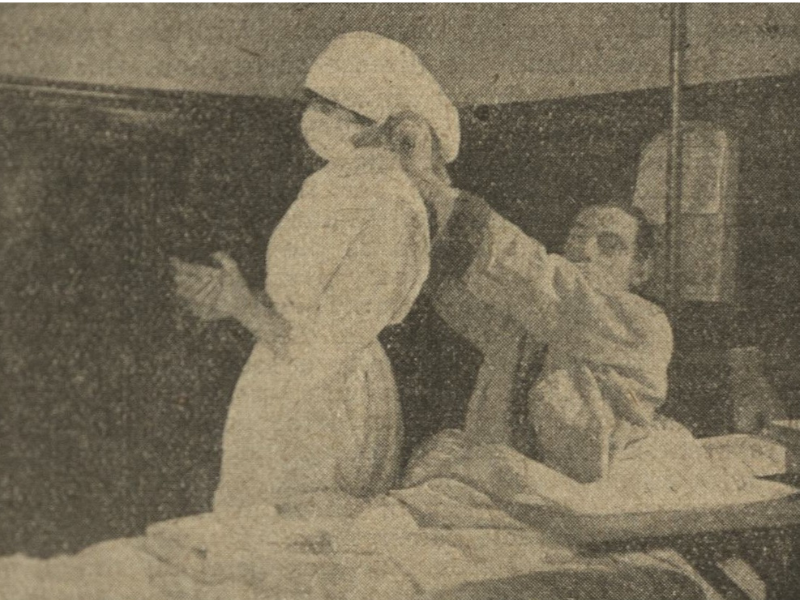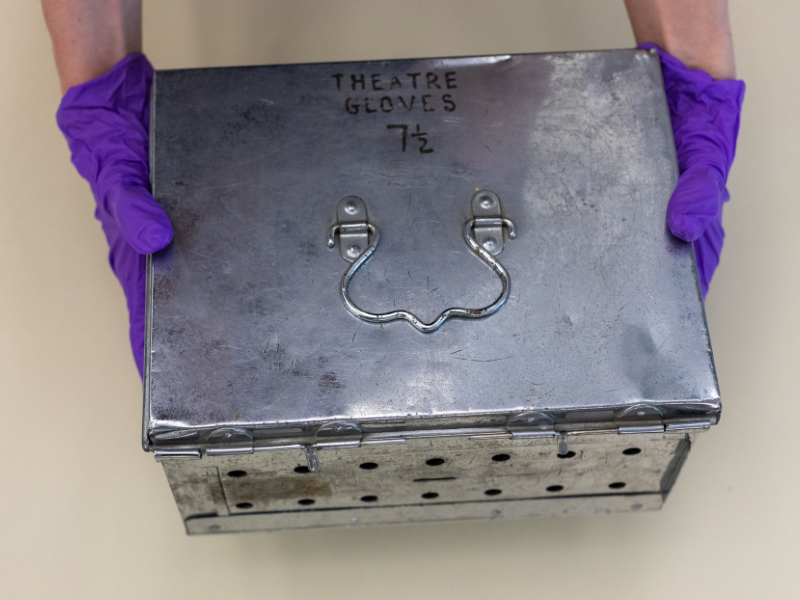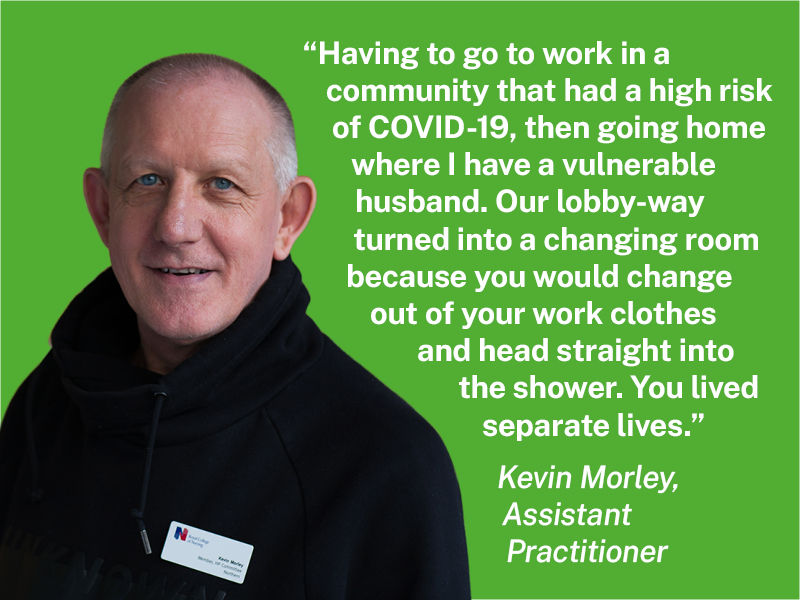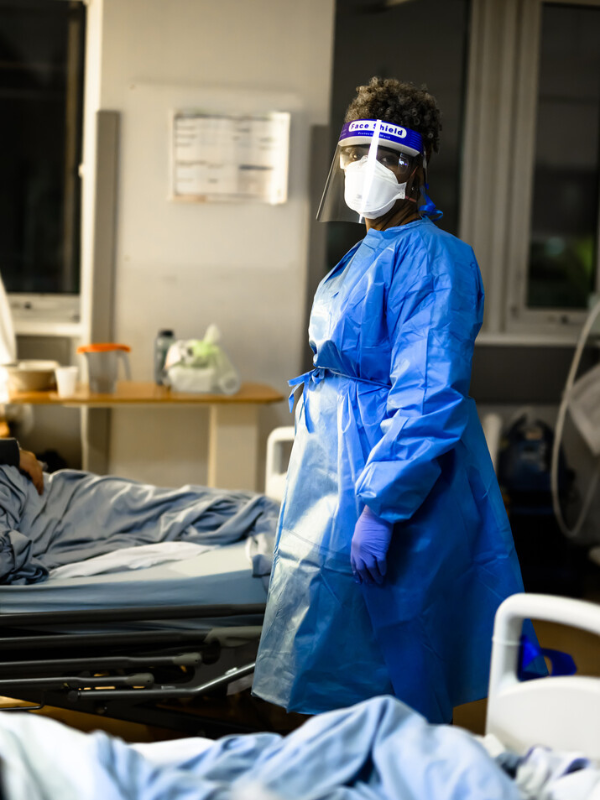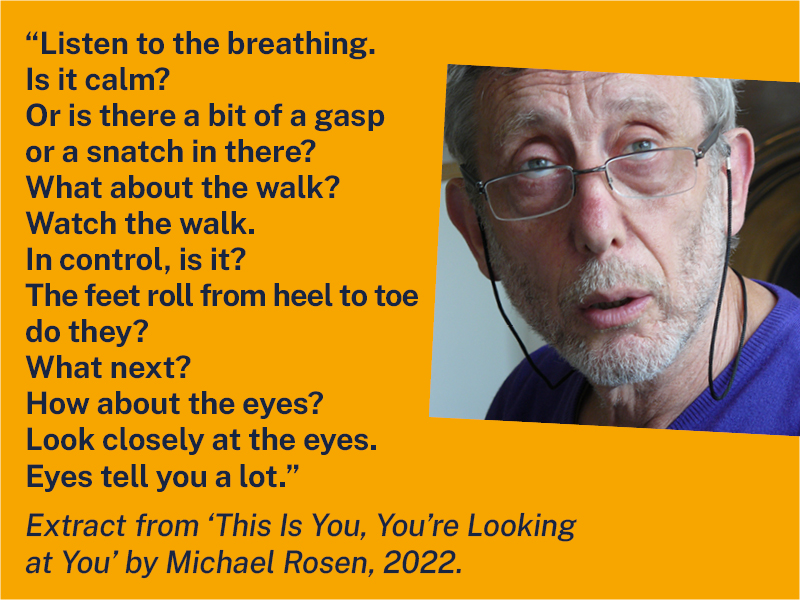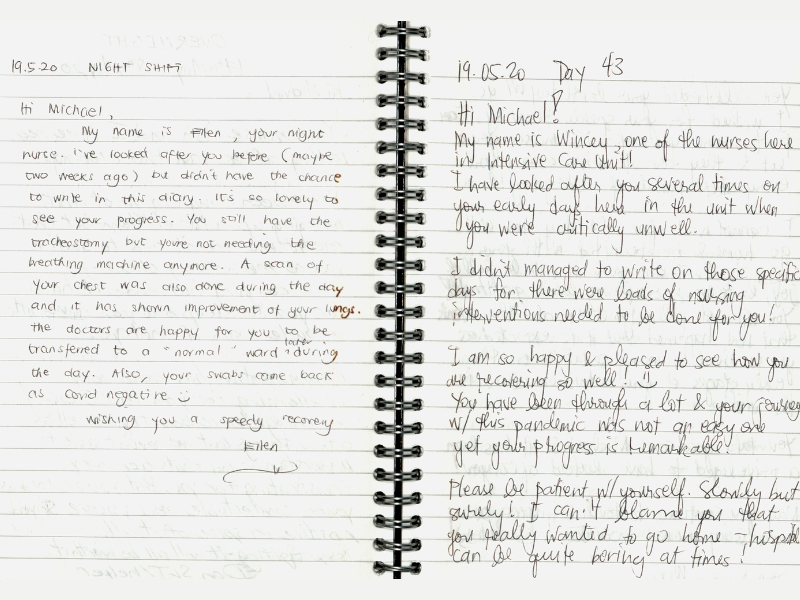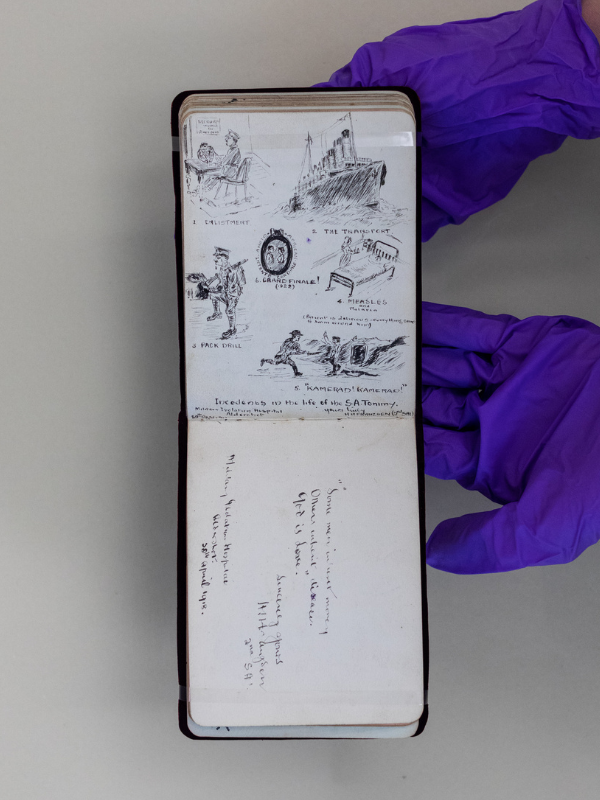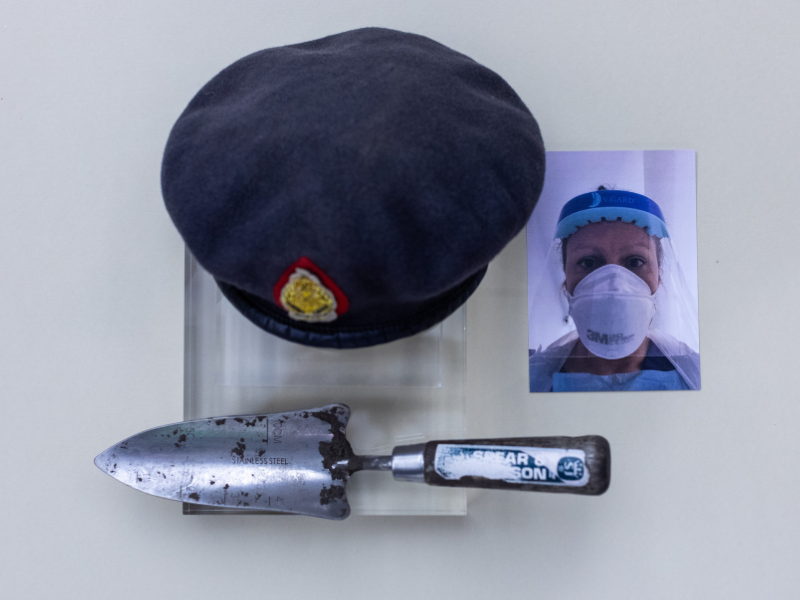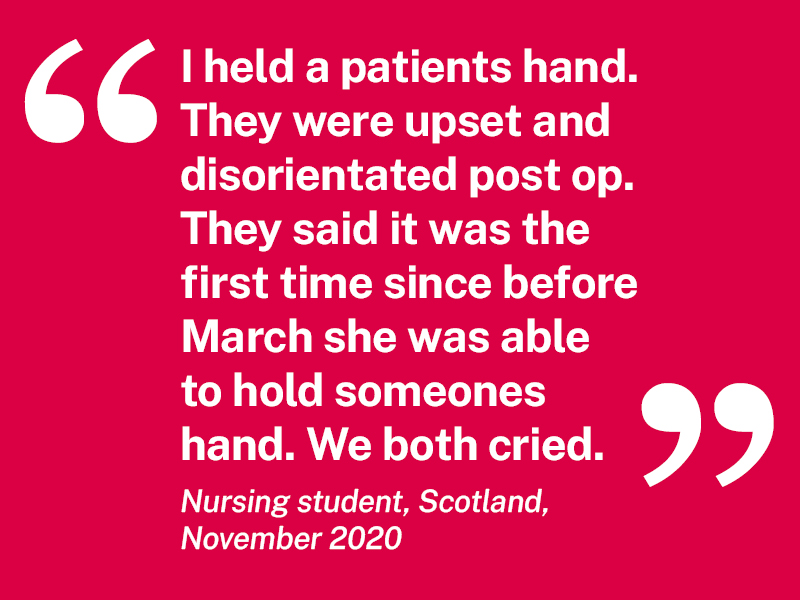This online exhibition explores the experiences of nursing staff during COVID-19 and past pandemics.
In the early months of the COVID-19 pandemic, the public clapped for nursing staff as masked heroes. Yet many nursing on the front line during COVID-19 felt they were just doing their job. And this pandemic, like others before it, exposed the risks taken every day by nursing professionals at work.
Over 850 healthcare workers are thought to have died after contracting COVID-19 in 2020 and, of course, the pandemic was not equal. It impacted some staff more than others, particularly those from Black, Asian and minority ethnic backgrounds.
If you have been affected by any of these issues, you can find a list of support resources at the end of the exhibition.
Masked professionals
Protection against infection has always been key in nursing, and never more so than during a pandemic. The public became used to seeing nursing staff putting on full Personal Protective Equipment (PPE) – masks, gowns, gloves, visors and, aprons.
In the early days of COVID-19, nursing professionals were expected to carry on caring despite shortages of the correct PPE. They did so at huge cost to themselves and their families.
This is not the first time that nurses have not been given the given the proper protection. In the 1918 flu pandemic, many hospitals were at first reluctant to allow nurses to wear masks. At the London Hospital in Whitechapel, for example, the committee worried that masks would alarm patients and other nurses. Horrified by how many nurses became sick, they gave in. They agreed that masks could be worn as long as they did not have a negative ‘psychological effect’ on patients.
Humans not Heroes
China Plate Theatre and Coventry University began the Humans Not Heroes project in 2020 in response to the COVID-19 pandemic. Healthcare workers worked with writers, actors and a sound designer to co-create five audio artworks based on their real-life experiences of working throughout the pandemic. Participants are from a variety of roles and experiences, from up and down the country.
As part of the exhibition programme, China Plate has run a series of workshops inviting RCN members to help create a new audio artwork titled 'Rescue Mission'. A new audio piece will be made with RCN members when the exhibition moves to Scotland.
In Isolation
It’s hard to forget the loneliness of lockdown. We met our loved ones through computer screens and became used to social distancing. But what is it like to nurse in isolation?
Infectious diseases have long been managed though confinement and quarantine. Isolation wards were common in workhouses and hospitals before the discovery of antibiotics. In the 1920s and 1930s, the number of specialist hospitals to treat infectious patients grew. Tuberculosis sanatoriums and fever hospitals were often in the countryside, making the nurses who worked and lived there doubly isolated.
During COVID-19, the risks nursing staff took at work had a cost for their lives at home. Many worried about taking back infection to vulnerable loved ones and made the difficult decision to live away from home.
This isolation has not ended. More than 100,000 nursing staff continue to suffer from Long Covid. Some cannot work and remain isolated at home. Others work on, despite breathlessness, pain and exhaustion, their symptoms hidden behind a mask.
Hospital Zoning
Nursing takes place in spaces that are carefully organised to minimise the spread of infection. However, when COVID-19 hit, nursing staff had to adjust to the total transformation of their usual working environments. Intensive care units took over wards that had previously been used for routine operations. Patients with confirmed or suspected COVID-19 were treated in ‘hot’ zones kept strictly separate from ‘cold’ non-COVID-19 zones.

A purpose-built isolation hospital, 1880s. Long corridors separate wards designed to segregate contagious patients.

Hospitals used a range of zoning systems to limit the spread of COVID-19. This floorplan has been produced for the purposes of illustration only.
Doodle wall
This image brings together the artwork and voices of participants in a series of creative doodling workshops run by graphic artist and facilitator Federica Ciotti. The ‘Time to Doodle’ workshops aimed to create a safe and creative space for RCN members to share their experiences of the COVID-19 pandemic.
The workshops used the art of doodling as both a therapeutic activity and as a creative method to generate ideas, tell stories, and to facilitate learning and understanding.
“Smiling with our eyes”
Care is complex. Tasks like checking blood pressure are easy to see but the emotional work of nursing is often forgotten. It too makes a huge difference to a patient’s recovery, not least in the fearful days of a global pandemic.
Nursing staff juggle the physical and mental demands of their work with just keeping their patients calm. In extreme situations, this becomes even harder. During the First World War, Beatrice Longmire worked at Aldershot Military Isolation Hospital treating soldiers who had contracted infectious diseases on the frontline. She kept a scrapbook, and her patients covered its pages in drawings, sketches and poems. These give us an insight into nurses’ lives under extreme stress, and the intense but fleeting connections made with others.
COVID-19 also made huge demands on the feelings of nursing staff. Poet and children’s author Michael Rosen remembers little of the 48 days he spent in an induced coma during the pandemic. Specialist nurses helped to fill in this gap by keeping a painstaking diary of his care.
Michael dedicated a poem to these NHS nurses, recognising how the work of caring can be just as draining as the physical demands of nursing.
“Claps don’t pay the bills”
During the pandemic, nursing staff went above and beyond at a time of national emergency. But that doesn’t mean that it was always easy or that their contribution has been properly recognised. It also doesn’t mean COVID-19 has gone away.
The pandemic made it clearer than ever that nursing staff deserve respect, safe staffing and fair pay. Now that the clapping is over, what comes next?
Support
For further support on the issues raised in our exhibition on Nursing and COVID-19, please visit the following pages:
- British Red Cross National support Line: 0808 196 3651
- Campaign Against Living Miserably (CALM) Support Line: 0800 58 58 58
- Marie Curie Bereavement Support Resources
- Samaritans Support Line: 116 123 Welsh Language Line (7pm-11pm): 0300 123 3011
- Shout Text SHOUT to 85258
Further support for RCN Members:
- The RCN offers a range of support, including counselling, and resources to help your wellbeing
- The first step is to get in touch with RCN Direct
- There is more information about the counselling service
Credits
With thanks to the RCN members and other participants who have shared their stories and objects for this exhibition, and to the History of Nursing Forum, staff from the RCN Library and Archive Service and across the RCN.
Thanks too to Eve Lloyd and our lenders, Barts Health NHS Trust Archives and Museums, the Red Cross Museum and Archives and the Old Operating Theatre.
The Doodle Wall was designed by Federica and includes the work and words of: Janette Astles, Katrina Cooper, Rob Hall, Antonia Harland-Lang, Eve Katherine Lloyd, Edwina Lugg, Naseem Nanji, Imogen Partridge. Other contributors preferred to remain anonymous. The wall also includes a selection of quotes from interviews with RCN members and two portraits of nursing staff on the picket line, by artist Jonny Kemp.
